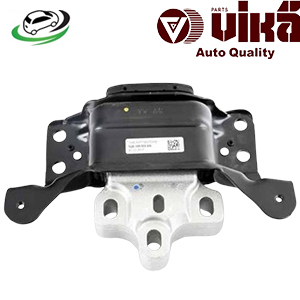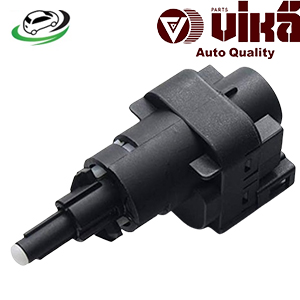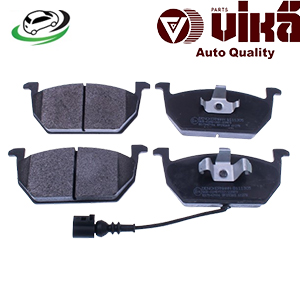Get VW Golf Mk7 / Audi A3 Front Brake Pad Set 5Q0698151C
The front brake pad set is an essential component of a vehicle’s braking system, playing a crucial role in ensuring safety and performance. Brake pads are responsible for generating friction against the brake rotors, allowing the vehicle to slow down or come to a complete stop. Understanding the functions, types, installation, maintenance, and performance characteristics of front brake pads is vital for any vehicle owner or automotive enthusiast.
Function of Brake Pads
- Friction Generation: The primary function of brake pads is to create friction against the brake rotors (also known as brake discs). When the driver presses the brake pedal, hydraulic pressure is applied to the brake calipers, which in turn pushes the brake pads against the rotors. The friction generated between the pads and rotors converts the kinetic energy of the moving vehicle into thermal energy, effectively slowing down or stopping the vehicle.
- Heat Dissipation: As brake pads generate friction, they also produce heat. Brake pads are designed to dissipate this heat efficiently to prevent brake fade—a reduction in braking effectiveness due to overheating. High-quality brake pads are constructed with materials that can withstand high temperatures while maintaining optimal performance.
- Noise Reduction: Modern brake pads often include features that help minimize noise during braking. Some pads are equipped with shims or other sound-dampening materials to reduce squeaking or grinding sounds, enhancing the overall driving experience.
- Wear Indicator: Many brake pads are designed with wear indicators, which are small metal clips or sensors that emit a squealing noise when the pads wear down to a certain level. This feature alerts the driver to the need for replacement, helping to prevent damage to the rotors.
Types of Front Brake Pads
Brake pads come in various materials, each with its advantages and disadvantages. Understanding the different types of brake pads can help vehicle owners make informed decisions about which pads best suit their driving habits and needs.
- Organic Brake Pads: Organic brake pads are made from a mixture of natural fibers, resins, and other materials. They are known for their quiet operation and low dust production. However, they typically wear out faster than other types and may not perform as well under high-stress conditions, such as aggressive driving or heavy loads.
- Advantages:
- Quiet operation
- Good initial bite
- Low dust production
- Disadvantages:
- Shorter lifespan
- Reduced performance under high heat
- Advantages:
- Semi-Metallic Brake Pads: Semi-metallic brake pads contain a blend of metal fibers (such as copper, steel, or iron) and other materials. These pads provide excellent braking performance, especially under high temperatures, making them suitable for performance and heavy-duty applications. However, they can produce more noise and dust than organic pads.
- Advantages:
- Excellent heat dissipation
- Long lifespan
- Strong braking performance
- Disadvantages:
- Increased noise
- Higher dust production
- Advantages:
- Ceramic Brake Pads: Ceramic brake pads are made from a mixture of ceramic fibers, non-ferrous materials, and bonding agents. They are known for their quiet operation, low dust production, and long lifespan. Ceramic pads provide consistent performance in various driving conditions, making them a popular choice for everyday driving.
- Advantages:
- Quiet operation
- Low dust production
- Long lifespan
- Disadvantages:
- Higher cost
- Reduced performance under extreme conditions
- Advantages:
- Low-Metallic NAO Brake Pads: Low-metallic non-asbestos organic (NAO) brake pads are similar to organic pads but contain a small amount of metal to enhance performance. They provide a good balance of performance and noise reduction while still offering a longer lifespan than traditional organic pads.
- Advantages:
- Good performance
- Moderate noise
- Longer lifespan than organic pads
- Disadvantages:
- Increased dust production
- May be noisier than pure organic pads
- Advantages:
Choosing the Right Brake Pads
When selecting brake pads for your vehicle, consider the following factors:
- Driving Style: Your driving habits significantly influence the type of brake pads that will perform best. If you primarily drive in a city with frequent stops, organic or ceramic pads may be ideal. For aggressive driving or towing heavy loads, consider semi-metallic pads for their durability and performance.
- Vehicle Type: The type of vehicle you drive also matters. Performance vehicles may benefit from semi-metallic pads, while daily drivers can often use ceramic or organic pads. Consider your vehicle’s specifications and manufacturer recommendations.
- Climate: Weather conditions can affect braking performance. In areas with extreme temperatures, semi-metallic pads may be better suited due to their heat resistance. Conversely, ceramic pads may perform better in moderate climates.
- Noise and Dust: If noise and dust are concerns, ceramic or organic pads are preferable, as they tend to produce less noise and brake dust. On the other hand, semi-metallic pads may be louder and create more dust.
Installation of Front Brake Pads
Replacing front brake pads is a common maintenance task that can be performed by a professional mechanic or a skilled DIY enthusiast. Here is a step-by-step guide for installing front brake pads:
Tools and Materials Needed:
- New brake pads
- Brake grease
- Jack and jack stands
- Lug wrench
- Socket set
- C-clamp or brake caliper tool
- Torque wrench
- Safety goggles
- Gloves
Installation Steps:
- Safety First: Ensure the vehicle is on a flat surface, engage the parking brake, and wear safety goggles and gloves.
- Lift the Vehicle: Use a jack to lift the front of the vehicle and secure it with jack stands. Remove the front wheels using a lug wrench.
- Remove the Brake Caliper: Locate the brake caliper, which houses the brake pads. Remove the caliper bolts with a socket set. Carefully slide the caliper off the rotor. Support it using a bungee cord or rope to avoid straining the brake line.
- Remove Old Brake Pads: Remove the old brake pads from the caliper bracket. Take note of their orientation for reference during installation.
- Compress the Caliper Piston: Use a C-clamp or brake caliper tool to compress the caliper piston. This step creates enough space for the new, thicker brake pads.
- Install New Brake Pads: Apply brake grease to the back of the new brake pads and install them into the caliper bracket. Ensure they are correctly oriented.
- Reinstall the Brake Caliper: Slide the caliper back over the new brake pads and rotor. Reattach the caliper bolts and torque them to the manufacturer’s specifications.
- Reattach the Wheels: Place the wheels back on the hub and hand-tighten the lug nuts. Lower the vehicle to the ground and then use a torque wrench to tighten the lug nuts to the proper specification.
- Test the Brakes: Before driving, pump the brake pedal several times to ensure the brake pads seat properly and the caliper piston is fully engaged.
Maintenance of Front Brake Pads
Maintaining your front brake pads is crucial for ensuring safety and performance. Here are some maintenance tips to consider:
- Regular Inspections: Inspect brake pads regularly for signs of wear. Check for uneven wear patterns, cracks, or thinning pads. Replace pads as necessary.
- Monitor Brake Performance: Pay attention to any changes in braking performance, such as increased stopping distances, noise, or vibrations. These could be signs of worn or damaged brake pads.
- Brake Fluid Check: Ensure the brake fluid is at the correct level and condition. Low or contaminated brake fluid can affect braking performance.
- Brake Rotor Maintenance: When replacing brake pads, check the condition of the brake rotors. Resurfacing or replacing rotors as needed will ensure optimal braking performance.
- Break-In New Pads: After installing new brake pads, perform a proper break-in procedure (also known as bedding) to ensure they seat correctly against the rotors. Follow the manufacturer’s recommendations for the break-in process.
Conclusion
The front brake pad set is a critical component of a vehicle’s braking system, ensuring safe and effective stopping power. Understanding the different types of brake pads, their functions, and proper maintenance practices is essential for every vehicle owner. By selecting the right brake pads for your driving style and ensuring proper installation and maintenance, you can enhance your vehicle’s performance, safety, and longevity. Regular inspections and timely replacements of worn brake pads will help you maintain optimal braking performance and drive with confidence.
Follow us on Facebook for more parts.




Reviews
Clear filtersThere are no reviews yet.